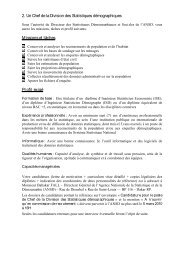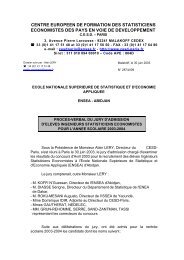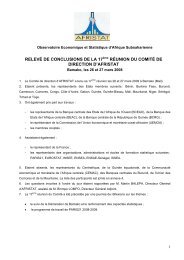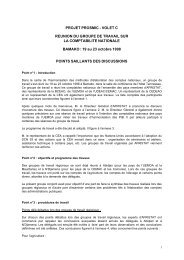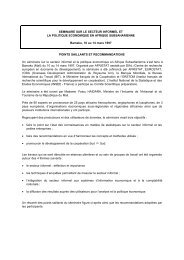Global Purchasing Power Parities and Real Expenditures - Afristat
Global Purchasing Power Parities and Real Expenditures - Afristat
Global Purchasing Power Parities and Real Expenditures - Afristat
You also want an ePaper? Increase the reach of your titles
YUMPU automatically turns print PDFs into web optimized ePapers that Google loves.
12 <strong>Global</strong> <strong>Purchasing</strong> <strong>Power</strong> <strong>Parities</strong> <strong>and</strong> <strong>Real</strong> <strong>Expenditures</strong>Table 2Economies with the Highest <strong>and</strong> Lowest GDP per CapitaGDP per capitaGDP per capitaHighest (percent of world average) Lowest (percent of world average)Luxembourg 780 Congo, Dem. Rep. 2.9Qatar 765 Liberia 4.3Norway 530 Guinea-Bissau 6.3Brunei Darussalam 529 Niger 6.5Kuwait 501 Ethiopia 6.6Source: ICP 2005.per capita of 17 economies was less than $1,000 (or lessthan 11 percent of the world average). In the richest 39economies, GDP per capita exceeded $20,000, which wasmore than double the world average of $8,900.Figure 2 shows the distribution of the global GDP byeconomy. The economies are arranged in the order of GDPper capita along the horizontal axis <strong>and</strong> presented as rectangles.The rectangle’s length along the horizontal scale correspondsto each economy’s share of the world population.Correspondingly, the GDP per capita as a percentage of theworld average is shown on the vertical axis. The economy’sGDP size would be then represented by the rectangle areafor each economy, which is the product of population <strong>and</strong>GDP per capita <strong>and</strong> thus would be directly comparableamong economies. As the economies are shown in increasingorder of real GDP per capita, the United States with thesixth largest GDP per capita is placed at the right, with theremaining countries reflected by the dark line because oftheir small population. The intersection of the 100 percentline with the rectangles shows that about three-fourths ofthe world population is in economies with per capita GDPbelow the world average.Even though China’s <strong>and</strong> India’s per capita consumptionsare both less than half of the world average, theireconomies rank number two <strong>and</strong> five, respectively, whichshows the effect of their large populations accounting forabout 40 percent of the world total.Figure 3 shows per capita measures by region forGDP, actual individual consumption, collective consumptionexpenditure by government, <strong>and</strong> gross fixed capitalformation.Per capita measures of PPP-based GDP are useful forcomparing average living st<strong>and</strong>ards in different economies.The Eurostat-OECD region has the highest GDP percapita, by a wide margin. The CIS is next, ahead of SouthAmerica <strong>and</strong> Western Asia.Actual Individual ConsumptionActual individual consumption (figure 3) is measured bythe total value of household final consumption expenditure,expenditures by nonprofit institutions serving households(such as nongovernmental organizations [NGOs] <strong>and</strong>charities), <strong>and</strong> government expenditure on individual consumptiongoods <strong>and</strong> services (such as education or health).On average, individual consumption constitutes 69 percentof GDP. Therefore, the regional distribution of individualconsumption per capita is very similar to that of GDP percapita. However, some differences can be seen in the Asia-Pacific <strong>and</strong> Western Asia regions, where consumption sharesare lower <strong>and</strong> investment rates are higher.Collective Government ConsumptionCollective government consumption (figure 3) consists ofexpenditures incurred by general <strong>and</strong> local governmentsfor collective consumption services such as defense, justice,general administration, <strong>and</strong> the protection of the environ-



